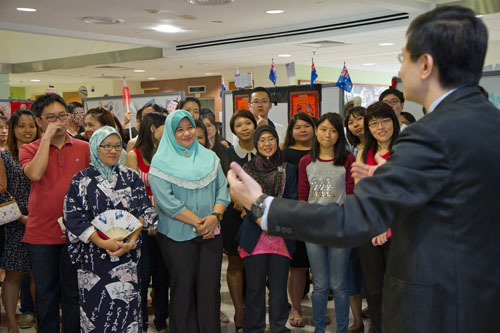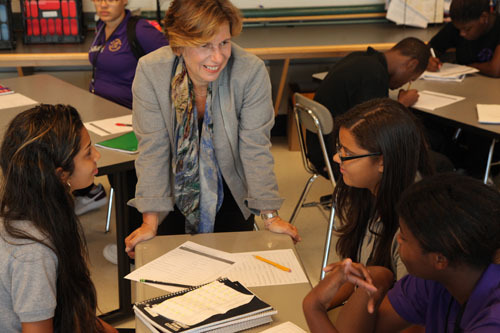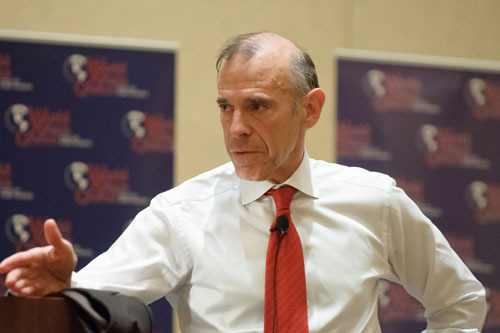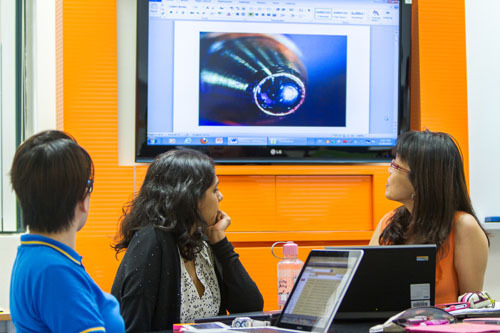
The Program of International Student Assessment (PISA) is an exam given every three years to 15 year olds around the world in reading, math and science. In the recent 2012 test, 65 countries and education systems participated: http://www.oecd.org/pisa/keyfindings/PISA-2012-results-snapshot-Volume-I-ENG.pdf. While the US did not perform well, impressive PISA gains were made in low-performing countries, such as Qatar and Kazakhstan. Some higher performing nations, such as Singapore, Poland, Germany and Italy, also made significant advances. PISA results are often used by governments around the world to justify decisions they wish to take on education policy. But should PISA be allowed to become the conclusive world exam for our kids? Today in The Global Search for Education, I have asked Pak Tee Ng, Tony Wagner and Randi Weingarten to share their perspectives.
Dr. Pak Tee Ng is Associate Dean, Leadership Learning, Office of Graduate Studies and Professional Learning at the National Institute of Education, Nanyang Technological University, Republic of Singapore. Dr. Tony Wagner is Expert in Residence at Harvard University’s Innovation Lab. Randi Weingarten is President of the American Federation of Teachers.

The PISA results provide some useful information about education systems. However, many subjects are not tested by PISA. How much credit should individual countries give to the PISA results as an accurate country by country comparison of student outcomes in Math, Science and Reading?
Tony Wagner: Unlike other tests such as NAEP or TIMSS, PISA tests students’ ability to apply what they have learned — to use knowledge in new situations, not just recall it. And so I think the broad trends that are revealed in the testing are very important to consider. The fact that after 11 years of No Child Left Behind, the US shows no progress in PISA whatsoever — while many other countries have made great strides — is perhaps the most significant finding for us. It tells us we are using the wrong strategies to improve education.
Pak Tee Ng: PISA is one of the few recognized international comparison tools for math, science and reading performance. Because of globalization, educational benchmarking with others provides a country an indication (not absolute measure) of its current and future competitiveness in the global market. So, PISA findings are useful in their own ways. However, PISA is not everything. It does not paint the entire picture. It does not test social skills or emotional maturity, or measure appreciation of sports and arts. Some have questioned the validity and reliability of the PISA tests, and whether certain jurisdictions ‘cheated’ on them. But, international comparisons in education standards can never be absolutely fair. The more important questions that countries have to ask themselves are why they are comparing with one another and what they are doing with the findings to improve the education of their children. Countries should take PISA results as a useful reference, not as a report card.
Randi Weingarten: There is never a perfect measure, particularly given the large variability internationally. That being said, PISA has a lot of good information. Countries (including the U.S.) should use PISA results along with other information to inform the way we improve our schools. We can’t continue to just look at the horse race and sigh that the United States is still doing poorly and move on until the next PISA report. It is incumbent on all policymakers to work with educators, parents and other stakeholders to actually learn the lessons of the top-performing countries and do what we know will work to make schools more equitable and successful.

Successful education systems globally are working to create alternative pathways (e.g. vocational) instead of just academic ones for students to find success. What are your thoughts on this?
Tony Wagner: Many of the most successful education systems — notably Finland — offer a career/technical pathway for students. In that country, nearly half of all students choose CTE (Career and Technical Education) over an academic curriculum. My research suggests that as many as half of the high school students in the US would also choose a high quality CTE curriculum if it were offered. With the un and under employment rate of recent college graduates now over 50% and the cost of college continuing to climb, a growing number of students are worried that a four year college education may not be the smart investment it once was. One of my biggest concerns about Common Core is that it appears to offer only a one size fits all college prep curriculum for all students.
Randi Weingarten: This is crucially important for our country. We must provide our students with fully supported, multiple tracks. The American Federation of Teachers has advocated high-quality CTE opportunities for years and we should look to countries that are successfully incorporating these programs, like Singapore, Germany, and those in northern Europe.
I visited the CTE institute in Singapore, which was impressive. They have the same emphasis on CTE as they do on traditional academic study. It was a well-funded, highly productive school that prepared students to immediately move into the Singaporean economy and have a successful career in hundreds of exciting areas.
Here in the U.S. we need to look at more collaborative efforts between school districts, businesses and higher education. When done well, high-quality career and technical education provides graduates with employment in good-paying 21st-century jobs, establishes a solid foundation for further education, and makes a vital connection for students between their high school educations and a tangible, desirable future. These programs have been found to lower drop-out rates and give students a defined pathway to a productive life doing meaningful work.
Pak Tee Ng: A good education system provides a platform for different talents to flourish and different aspirations to be fulfilled. It helps students, with different needs, inclinations and strengths, find success in their areas of study, be those in arts, sports or technical education. It encourages each student to find identity, meaning, and purpose through their school lives. So, I support the drive for education systems globally to develop many pathways for students to find success in their different areas.
In Singapore, we take a balanced approach. Students who can do well academically are given opportunities to develop their academic potential. But we also commit vast resources to level up every student and create more pathways for students to find success in their areas of strength. We try to educate our students so that they will contribute to society when they are successful.

School systems globally can learn from each other’s practices, but given the unique cultural and developmental trajectories of individual countries, how easy or difficult is it to copy practices?
Tony Wagner: Countries cannot necessarily “copy” practices of other countries, but we can learn a great deal from trends that we see elsewhere. For example, other countries like Sweden that have invested heavily in school choice have seen their scores decline sharply. While countries that have made significant investments in radically improving their teacher preparation programs have seen dramatically improved PISA scores.
Pak Tee Ng: The strengths of other systems should inspire us to reflect on our own system. But we cannot copy practices. We have to understand the underlying principle behind the success of others and find our own way to success, based on our unique culture and contexts. Finland and Singapore have been used often as examples of educational success. In Finland, all their teachers have a master’s degree. I do not think any education system can demand that of their teachers overnight! In Singapore, we have a national system for recruiting new teachers, training in-service teachers and developing school leaders. But one cannot take this idea and simply implement it in a decentralized system. The important lesson is to appreciate the underlying principle of having good teachers and school leaders, and taking their continuous professional development very seriously.
Randi Weingarten: Of course culture matters but there are clear lessons that cut across all cultures. First, teaching matters. We must build a profession of teaching that treats teachers as the educational experts they are. We must give our teachers the time, tools, and support they need to succeed. Schools must assure that teachers have a say in the decisions that affect their classrooms. Most importantly, teachers need time to collaborate with colleagues, time to prepare their lessons so they are the best teachers they can be. We need to stop the top-down accountability that has silenced innovation and build a more horizontal structure in schools where teachers work together and are accountable to each other instead of to a test score.
Andreas Schleicher (Deputy Director for Education and Skills, OECD Special Advisor on Education Policy) has said time and again, “an inequitable school system can never be a high-performing school system.” This concept transcends culture. All the high performing systems take active steps to address equity in schools. This is a lesson the U.S. must learn as soon as possible. PISA study after PISA study has shown the high level of inequity in our schools. U.S. schools mainly rely on property taxes for funding, which means poor areas receive far less funding than wealthy districts. Consequently, those who need the most resources don’t get them.

Photos are courtesy of AFT, Pak Tee Ng and Tony Wagner
In The Global Search for Education, join me and globally renowned thought leaders including Sir Michael Barber (UK), Dr. Michael Block (U.S.), Dr. Leon Botstein (U.S.), Professor Clay Christensen (U.S.), Dr. Linda Darling-Hammond (U.S.), Dr. Madhav Chavan (India), Professor Michael Fullan (Canada), Professor Howard Gardner (U.S.), Professor Andy Hargreaves (U.S.), Professor Yvonne Hellman (The Netherlands), Professor Kristin Helstad (Norway), Jean Hendrickson (U.S.), Professor Rose Hipkins (New Zealand), Professor Cornelia Hoogland (Canada), Honourable Jeff Johnson (Canada), Mme. Chantal Kaufmann (Belgium), Dr. Eija Kauppinen (Finland), State Secretary Tapio Kosunen (Finland), Professor Dominique Lafontaine (Belgium), Professor Hugh Lauder (UK), Professor Ben Levin (Canada), Lord Ken Macdonald (UK), Professor Barry McGaw (Australia), Shiv Nadar (India), Professor R. Natarajan (India), Dr. Pak Tee Ng (Singapore), Dr. Denise Pope (US), Sridhar Rajagopalan (India), Dr. Diane Ravitch (U.S.), Richard Wilson Riley (U.S.), Sir Ken Robinson (UK), Professor Pasi Sahlberg (Finland), Professor Manabu Sato (Japan), Andreas Schleicher (PISA, OECD), Dr. Anthony Seldon (UK), Dr. David Shaffer (U.S.), Dr. Kirsten Sivesind (Norway), Chancellor Stephen Spahn (U.S.), Yves Theze (Lycee Francais U.S.), Professor Charles Ungerleider (Canada), Professor Tony Wagner (U.S.), Sir David Watson (UK), Professor Dylan Wiliam (UK), Dr. Mark Wormald (UK), Professor Theo Wubbels (The Netherlands), Professor Michael Young (UK), and Professor Minxuan Zhang (China) as they explore the big picture education questions that all nations face today. The Global Search for Education Community Page
C. M. Rubin is the author of two widely read online series for which she received a 2011 Upton Sinclair award, “The Global Search for Education” and “How Will We Read?” She is also the author of three bestselling books, including The Real Alice in Wonderland.
Follow C. M. Rubin on Twitter: www.twitter.com/@cmrubinworld

Recent Comments